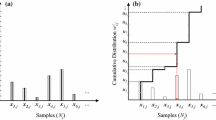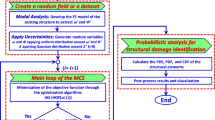Abstract
Bayesian damage identification method, due to its ability to consider the uncertainties, has attracted much attention from researchers. However, there are two key issues to ensure the accuracy of this method, namely, the damage identification objective function and sampling method. The existing objective function based on natural frequencies and mode shapes (FFM), due to the limitation of sensors leading to incomplete measurement, shows poor damage identification ability. Meanwhile, the sampling efficiency of the common sampling method [i.e., the standard Metropolis–Hastings (MH) algorithm] still needs to be enhanced. Aiming at these problems, this study proposes a new objective function based on autoregressive coefficients (FAR), and improves the standard MH algorithm by introducing the particle position updating mechanism in Particle Swarm Optimization (PSO), resulting in MH-PSO hybrid Markov Chain Monte Carlo sampling method (MH-PSO method); both of them are combined to form an improved Bayesian damage identification method. And then, two numerical examples of cantilever beam and American Society of Civil Engineers benchmark frame are exploited to evaluate the effectiveness of the proposed FAR and MH-PSO method, respectively. The results show that FAR has better damage identification ability for multiple damage case than FFM, and the proposed MH-PSO method illustrates better statistical efficiency than the Differential Evolution Monte Carlo method in the case of multi-damage of complex structure. Finally, the effectiveness and feasibility of the proposed improved Bayesian damage identification method has been validated by the experimental frame, whose outcome proves that the proposed method is feasible and accurate.
































Similar content being viewed by others
Data availability
Some or all data, models, or code that support the findings of this study are available from the corresponding author upon reasonable request.
References
Huang MS, Cheng XH, Lei YZ (2021) Structural damage identification based on substructure method and improved whale optimization algorithm. J Civ Struct Health 11(2):351–380. https://doi.org/10.1007/s13349-020-00456-7
Huang MS, Cheng XH, Zhu ZG et al (2021) A novel two-stage structural damage identification method based on superposition of modal flexibility curvature and whale optimization algorithm. Int J Struct Stab Dyn 21(12):2150169. https://doi.org/10.1142/s0219455421501698
Huang MS, Lei YZ, Li XF (2019) Structural damage identification based on l1regularization and bare bones particle swarm optimization with double jump strategy. Math Probl Eng 2019:5954104. https://doi.org/10.1155/2019/5954104
Huang MS, Gül M, Zhu HP (2018) Vibration-based structural damage identification under varying temperature effects. J Aerosp Eng 31(3):04018014. https://doi.org/10.1061/(asce)as.1943-5525.0000829
Sohn H, Law KH (1997) A Bayesian probabilistic approach for structure damage detection. Earthq Eng Struct D 26(12):1259–1281. https://doi.org/10.1002/(SICI)1096-9845(199712)26:12%3c1259::AID-EQE709%3e3.0.CO;2-3
Beck JL, Katafygiotis LS (1998) Updating models and their uncertainties. I: Bayesian statistical framework. J Eng Mech 124(4):455–461. https://doi.org/10.1061/(asce)0733-9399(1998)124:4(455)
Yuen KV, Au SK, Beck JL (2004) Two-stage structural health monitoring approach for phase I benchmark studies. J Eng Mech 130(1):16–33. https://doi.org/10.1061/(asce)0733-9399(2004)130:1(16)
Ching J, Beck JL (2004) Bayesian analysis of the phase II IASC–ASCE structural health monitoring experimental benchmark data. J Eng Mech 130(10):1233–1244. https://doi.org/10.1061/(asce)0733-9399(2004)130:10(1233)
Yin T, Jiang QH, Yuen KV (2017) Vibration-based damage detection for structural connections using incomplete modal data by Bayesian approach and model reduction technique. Eng Struct 132:260–277. https://doi.org/10.1016/j.engstruct.2016.11.035
Wang XY, Hou RR, Xia Y et al (2021) Structural damage detection based on variational Bayesian inference and delayed rejection adaptive Metropolis algorithm. Struct Health Monit 20(4):1518–1535. https://doi.org/10.1177/1475921720921256
Hou RR, Xia Y, Zhou XQ et al (2021) Sparse Bayesian learning for structural damage detection using expectation–maximization technique. Struct Control Health 26(5):e2343. https://doi.org/10.1002/stc.2343
Lam HF, Yang JH, Hu Q et al (2018) Railway ballast damage detection by Markov chain Monte Carlo-based Bayesian method. Struct Health Monit 17(3):706–724. https://doi.org/10.1177/1475921717717106
Behmanesh I, Moaveni B, Papadimitriou C (2017) Probabilistic damage identification of a designed 9-story building using modal data in the presence of modeling errors. Eng Struct 131:542–552. https://doi.org/10.1016/j.engstruct.2016.10.033
Fang SE, Chen S, Lin YQ et al (2019) Probabilistic damage identification incorporating approximate Bayesian computation with stochastic response surface. Mech Syst Signal Process 128:229–243. https://doi.org/10.1016/j.ymssp.2019.03.044
Behmanesh I, Moaveni B, Lombaert G et al (2015) Hierarchical Bayesian model updating for probabilistic damage identification. Model Valid Uncertain Quantif 3:55–66. https://doi.org/10.1007/978-3-319-15224-0_6
Li BJ, Lei YZ, Zhou DM et al (2021) Bearing damage detection of a bridge under the uncertain conditions based on the Bayesian framework and matrix perturbation method. Shock Vib 2021:5576362. https://doi.org/10.1155/2021/5576362
Seyedpoor SM, Ahmadi A, Pahnabi N (2019) Structural damage detection using time domain responses and an optimization method. Inverse Probl Sci Eng 27(5):669–688. https://doi.org/10.1080/17415977.2018.1505884
Fallahian S, Joghataie A, Kazemi MT (2018) Structural damage detection using time domain responses and teaching–learning-based optimization (TLBO) algorithm. Sci Iran 25(6):3088–3100. https://doi.org/10.24200/sci.2017.4238
Nair KK, Kiremidjian AS, Law KH (2006) Time series-based damage detection and localization algorithm with application to the ASCE benchmark structure. J Sound Vib 291(1–2):349–368. https://doi.org/10.1016/j.jsv.2005.06.016
Zhu HP, Yu H, Gao F et al (2020) Damage identification using time series analysis and sparse regularization. Struct Control Health Monit 27(9):e2554. https://doi.org/10.1002/stc.2554
Tang QZ, Zhou JT, Xin JZ et al (2020) Autoregressive model-based structural damage identification and localization using convolutional neural networks. KSCE J Civ Eng 24:2173–2185. https://doi.org/10.1007/s12205-020-2256-7
Beck JL, Au SK (2002) Bayesian updating of structural models and reliability using Markov chain Monte Carlo simulation. J Eng Mech 128(4):380–391. https://doi.org/10.1061/(asce)0733-9399(2002)128:4(380)
TerBraak CJF (2006) A Markov Chain Monte Carlo version of the genetic algorithm Differential Evolution: easy Bayesian computing for real parameter spaces. Stat Comput 16(3):239–249. https://doi.org/10.1007/s11222-006-8769-1
Sherri M, Boulkaibet I, Marwala T et al (2019) A differential evolution Markov chain Monte Carlo algorithm for Bayesian model updating. Spec Top Struct Dyn 5:115–125
Ding ZH, Li J, Hao H (2019) Structural damage identification using improved Jaya algorithm based on sparse regularization and Bayesian inference. Mech Syst Signal Process 132:211–231. https://doi.org/10.1016/j.ymssp.2019.06.029
Ding ZH, Li J, Hao H et al (2019) Structural damage identification with uncertain modelling error and measurement noise by clustering based tree seeds algorithm. Eng Struct 185:301–314. https://doi.org/10.1016/j.engstruct.2019.01.118
Du DC, Vinh HH, Trung VD et al (2018) Efficiency of Jaya algorithm for solving the optimization-based structural damage identification problem based on a hybrid objective function. Eng Optim 50(8):1233–1251. https://doi.org/10.1080/0305215x.2017.1367392
Seyedpoor SM (2012) A two stage method for structural damage detection using a modal strain energy based index and particle swarm optimization. Int J Nonlinear Mech 47(1):1–8. https://doi.org/10.1016/j.ijnonlinmec.2011.07.011
Yin T, Zhu HP, Fu SJ (2019) Damage identification of periodically-supported structures following the Bayesian probabilistic approach. Int J Struct Stab Dyn 19(01):1940011. https://doi.org/10.1142/s021945541940011x
Akaike H (1987) Factor analysis and AIC. Psychometrika 52(3):317–332. https://doi.org/10.1007/bf02294359
Chen ZP, Yu L (2017) A novel PSO-based algorithm for structural damage detection using Bayesian multi-sample objective function. Struct Eng Mech 63(6):825–835. https://doi.org/10.12989/sem.2017.63.6.825
Tran-Ngoc H, Khatir S, DeRoeck G et al (2018) Model updating for Nam O bridge using particle swarm optimization algorithm and genetic algorithm. Sensors 18(12):4131. https://doi.org/10.3390/s18124131
Ventura CE, Lord JF, Turek M et al (2003) Experimental studies and remote monitoring of IASC-ASCE benchmark test frame. In: Proceedings of the 21st international modal analysis conference (IMAC), Orlando, FL, USA. http://citeseerx.ist.psu.edu/viewdoc/summary?doi=10.1.1.473.3046
Johnson EA, Lam HF, Katafygiotis LS et al (2004) Phase I IASC-ASCE structural health monitoring benchmark problem using simulated data. J Eng Mech 130(1):3–15. https://doi.org/10.1061/(asce)0733-9399(2004)130:1(3)
Bernal D, Dyke SJ, Lam HF et al (2002) Phase II of the ASCE benchmark study on SHM. In: Proceedings of the 15th ASCE engineering mechanics conference. Columbia University, New York. https://resolver.caltech.edu/CaltechAUTHORS:20120919-153813974
Lam HF (2003) Phase IIe of the IASC-ASCE benchmark study on structural health monitoring. In: IMAC-XXI: a conference and exposition on structural dynamics, Kissimmee, FL, USA. http://hdl.handle.net/1783.1/28551
Huang MS, Li XF, Lei YZ (2020) Structural damage identification based on modal frequency strain energy assurance criterion and flexibility using enhanced Moth-Flame optimization. Structures 28:1119–1136. https://doi.org/10.1016/j.istruc.2020.08.085
Flegal JM, Haran M, Jones GL (2008) Markov chain Monte Carlo: can we trust the third significant figure? Stat Sci 23(2):250–260. https://doi.org/10.1214/08-sts257
Figueiredo E, Park G, Figueiras J et al (2009) Structural health monitoring algorithm comparisons using standard data sets. Los Alamos National Lab (LANL), Los Alamos. https://doi.org/10.2172/961604
Yuliastuti Y, Setiadipura T (2018) Winston-Batan: a seismological ground-motion analysis code. J Nat 18(3):152–160. https://doi.org/10.24815/jn.v18i3.12201
Acknowledgements
This study was supported by the National Natural Science Foundation of China (Project No. 52178300), the Graduate Innovative Fund of Wuhan Institute of Technology (Project No. CX2021112), and the Plan of Outstanding Young and Middle-aged Scientific and Technological Innovation Team in Universities of Hubei Province, China (Project No. T2020010).
Author information
Authors and Affiliations
Corresponding author
Ethics declarations
Conflict of interest
The authors declare that they have no conflicts of interest.
Additional information
Publisher's Note
Springer Nature remains neutral with regard to jurisdictional claims in published maps and institutional affiliations.
Rights and permissions
About this article
Cite this article
Luo, J., Huang, M., Xiang, C. et al. Bayesian damage identification based on autoregressive model and MH-PSO hybrid MCMC sampling method. J Civil Struct Health Monit 12, 361–390 (2022). https://doi.org/10.1007/s13349-021-00541-5
Received:
Revised:
Accepted:
Published:
Issue Date:
DOI: https://doi.org/10.1007/s13349-021-00541-5




